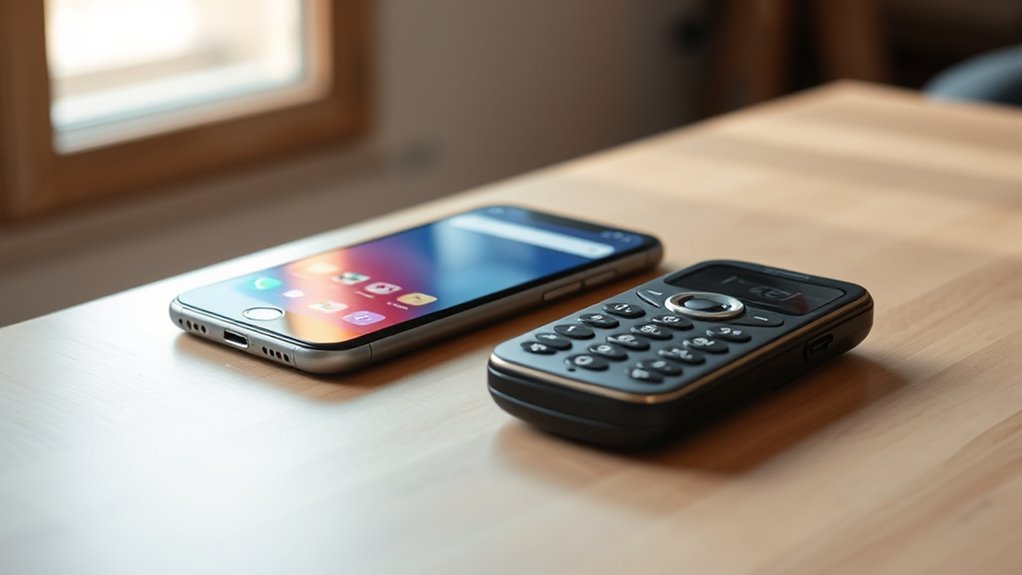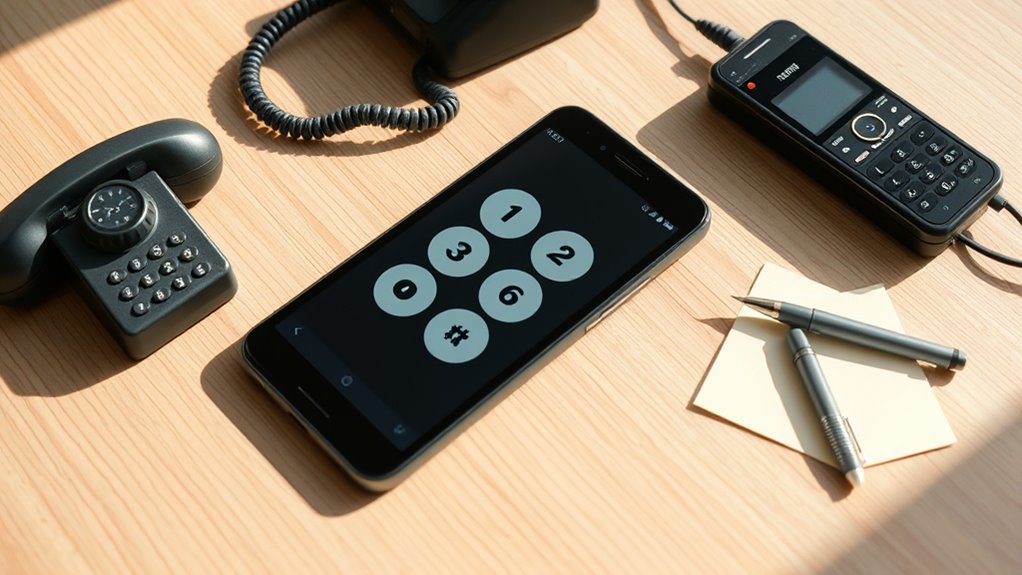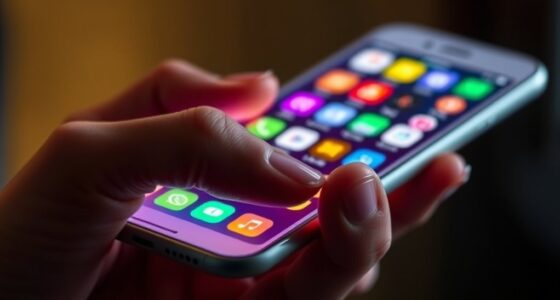To turn your smartphone into a dumbphone without buying a new device, start by disabling or limiting non-essential notifications to prevent constant distractions. uninstall or hide apps that aren’t necessary, focusing only on calls and texts. use focus modes or do not disturb features to create silent periods and set boundaries for screen time. by making these adjustments, you’ll create a simpler, more purpose-driven device—if you keep exploring, you’ll find more tips to reduce digital clutter.
Key Takeaways
- Disable or limit non-essential notifications and alerts to reduce distractions.
- Uninstall or hide social media and gaming apps to minimize temptation.
- Use focus modes or do not disturb features to create silent, distraction-free periods.
- Set boundaries with tech-free zones or times, like during meals or before bed.
- Keep only essential functions on your device, turning it into a simple, purposeful tool.

Have you ever wished your smartphone could be simpler, free from constant notifications and distractions? If so, you’re not alone. Many people seek a way to regain control over their digital lives without investing in a whole new device. Turning your smartphone into a “dumbphone” is a practical approach that helps you achieve this goal. You don’t need to buy a separate, basic phone; instead, you can modify your current device to limit its functionality, promoting a healthier relationship with technology. This process is especially effective for those aiming for a digital detox or better screen time management. By reducing the temptation to scroll endlessly or check notifications every few minutes, you create space for more meaningful activities and real-world connections.
Simplify your smartphone for healthier, distraction-free living without buying a new device.
The first step involves adjusting your device’s settings to disable or limit notifications and app alerts. Most smartphones now have built-in features that let you customize notification preferences. Turn off non-essential alerts, especially for social media, news, and messaging apps. This reduces the constant pinging that pulls you back into mindless scrolling. Additionally, you can use “focus modes” or “do not disturb” settings to create designated periods where your phone is fundamentally silent, allowing you to concentrate on tasks or relax without distraction. These small tweaks are instrumental in practicing screen time management, helping you break the cycle of compulsive checking and reducing digital clutter. Moreover, understanding the importance of contrast ratio in display quality can help you choose or adjust your device settings for a more comfortable viewing experience.
Next, consider uninstalling or hiding apps that are not necessary. Keep only essential functions like calls, texts, and perhaps a minimal calendar or notes app. If you’re hesitant to delete certain apps, hide them from your home screen or move them into folders so they’re less accessible. This physical or visual barrier makes it easier to resist the urge to open social media or gaming apps. By doing so, you’re effectively transforming your smartphone into a simplified device—more like a dumbphone—that serves basic communication needs without the endless stream of digital distractions.
Finally, set specific boundaries for your screen time. Establish “tech-free” zones or hours during your day, such as during meals, before bed, or during work. Use screen time management tools to monitor and limit your usage. This helps cement the habit of digital detox, making your phone a tool rather than a constant source of entertainment or stress. The goal is to create a more mindful relationship with your device, one that supports your well-being rather than undermines it. Turning your smartphone into a dumbphone isn’t about giving up technology but about controlling it—making your digital life more intentional, less overwhelming, and ultimately, more free.
Frequently Asked Questions
Can I Revert My Phone Back to a Smartphone Easily?
Yes, you can revert your phone back to a smartphone easily. You just need to reinstall the necessary apps to restore full app functionality and adjust your settings to enable features you previously disabled. Keep in mind, this process can impact user privacy, so review app permissions and security settings carefully. Once done, your device will function as a regular smartphone again, with all the features and flexibility you’re used to.
Will Turning My Phone Into a Dumbphone Affect App Data?
Turning your phone into a dumbphone can impact app data preservation and app functionality. Some apps might lose data or not work properly since you’re limiting access or disabling certain features. To minimize this, back up important app data before making changes and choose settings that preserve data when possible. Keep in mind, some apps may not function fully once you restrict their capabilities, affecting your user experience.
Is This Method Compatible With All Smartphone Brands?
This method isn’t compatible with all smartphone brands, as brand compatibility varies. Some devices support the necessary features, while others face limitations. You might encounter feature limitations depending on your phone’s operating system or manufacturer restrictions. Before proceeding, check your device’s compatibility and available settings. If your phone isn’t fully supported, you may need alternative solutions or consider switching to a device with better compatibility for turning it into a dumbphone.
How Does This Affect My Phone’s Software Updates?
Turning your smartphone into a ‘dumbphone’ mainly affects software update impact, as fewer updates are necessary once you disable or limit smart features. However, it might also reduce ongoing security patches, so your device could become more vulnerable over time. Privacy considerations improve because you limit data sharing and tracking, but keep in mind that some background processes might still run. Overall, it’s a practical way to simplify your phone while maintaining control.
Are There Security Risks in Disabling Smart Features?
Disabling smart features can increase your privacy concerns by reducing data sharing, but it may also create hacking vulnerabilities if you disable security patches or leave system flaws unpatched. Be cautious, as some features might still be vulnerable without proper updates. To stay safe, disable only non-essential smart features, and regularly check for security updates to minimize your risks of hacking vulnerabilities.
Conclusion
So, could turning your smartphone into a dumbphone actually help you regain focus and reduce stress? While some say it’s just a trendy fad, evidence suggests disconnecting from constant notifications can boost your mental well-being. Before you dismiss it, consider trying this simple switch—you might find that less screen time leads to more real-life moments and clarity. Sometimes, going back to basics isn’t just a theory; it’s a smart move for your mind.






